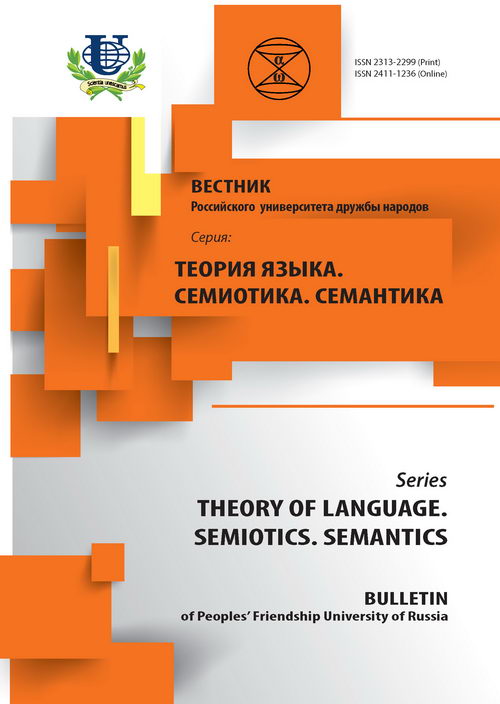No 2 (2011)
- Year: 2011
- Articles: 15
- URL: https://journals.rudn.ru/semiotics-semantics/issue/view/448
Articles
The Editor-in-Chief preface
RUDN Journal of Language Studies, Semiotics and Semantics. 2011;(2):5-6
 5-6
5-6


An Essay on Semantic Field
RUDN Journal of Language Studies, Semiotics and Semantics. 2011;(2):7-17
 7-17
7-17


Semantic Field: Syntagmatics and Paradigmatics
Abstract
Dialectical unity and interaction of system and structure let position a semantic field as a semiotic sphere in language lexis and grammar. Semantic field does not just compose a part of the lexico-semantic language system, but as a means of its organization and analysis. The leading role belongs to the function determined by the dominant of a semantic field.
RUDN Journal of Language Studies, Semiotics and Semantics. 2011;(2):18-24
 18-24
18-24


 25-32
25-32


Vita of Protopope Avvakum: New Style Semiotics
Abstract
Typical of the Mediaeval texts 'form and content' correlation is being transgressed in the Protopope Avvakum's works. To understand the mechanism of this deviation - and in accordance with the given interpretation - to formulate approved criteria of Avvakum's texts analysis - is the main task of the article.
RUDN Journal of Language Studies, Semiotics and Semantics. 2011;(2):33-40
 33-40
33-40


Intonation as a Means of the Formal Differentiation of Lexico-Semantic Variations of a Polysemantic Russian Word
Abstract
The article treats the problem of the formal differentiation of a lexico-semantic variations of polysemantic word by means of intonation differences. The analysis of the Russian polysemants allows to define the formal differentiation of LSV as a regular systemic phenomenon, determined by the language position on the scale of lexicality-grammaticality. The extent and depth of dividing a word into grammatical and lexical parts determine the predominant usage of the formal differentiation means. In the unchangeable synsemantic word classes both intonation and stress are used. The stress independence/dependence of the synsemantic parts of speech LSV depends on their functional and syntactic status which is due to their semantic difference.
RUDN Journal of Language Studies, Semiotics and Semantics. 2011;(2):41-48
 41-48
41-48


The Reflection of Stylistic Synonymy in the IN THE Context of Literary Works
Abstract
The article treats a linguistic problem proceeding from the specific features of nomination and the peculiarities of meanings of stylistic synonyms as well as regular patterns of their realization in the context of literary works. Basing on E. Kurilovich theory, there's shown that contextual environment influences on the word meaning in those cases when it coincides with the meaning of another word or phrase existing in the language, or if a semantic correlation is revealed between this word and another one as being repeated in the system of the given language.
RUDN Journal of Language Studies, Semiotics and Semantics. 2011;(2):49-53
 49-53
49-53


On the Project of Multimedia Dictionary of Russian Culture Sound Gestures
Abstract
Sound gestures are the synthetic phonologically indivisible communicative signs of national culture, which are only partially represented in the written form by interjections and expressive particles. The nonverbal component of these signs cannot be isolated from its verbal-aural component. Such signs require special systematic semiographic description within the national (in our case - Russian) sound gestures dictionary. The project of multimedia dictionary of Russian sound gestures is described and proposed in the article.
RUDN Journal of Language Studies, Semiotics and Semantics. 2011;(2):54-63
 54-63
54-63


Metaphorical Interpretation of Time Flow in Language World Picture (on the Material of the Russian and English Languages)
Abstract
The article is devoted to the study of metaphorical nominations characterizing different aspects of time category which is considered to be most fruitful for the description of time as a fragment of a language world picture.
RUDN Journal of Language Studies, Semiotics and Semantics. 2011;(2):64-69
 64-69
64-69


 70-74
70-74


A study of Semantics Fields as a means of the Text Construction: based on the on Russian and Chinese Poems
Abstract
In this article semantic field has been studied as a means of text construction, which is a challenge to the traditional way of study it within the field of lexicology. The research contents that the semantic field reveals promising prospects for the analysis of the semantic relation of lexicon in text, the syntactic semantic relation of text and the semantic construction of text.
RUDN Journal of Language Studies, Semiotics and Semantics. 2011;(2):75-79
 75-79
75-79


Composition Techniques and Research Area of Xang Yuj's Essay Tao Ancestry
Abstract
The article analyzes one of the most well-known essays of Xang Yuj (768-824), Chinese poet, prose writer and political figure of the dynasty Tang period. The author of the article reviews composition technics, used by Xang Yuj to create the text, and retraces the progress of the essay's research area through different philosophic, mainly Confucian categories mentioned in the essay.
RUDN Journal of Language Studies, Semiotics and Semantics. 2011;(2):80-88
 80-88
80-88


Chinese Cinema and Films: Organizational and Lingvo-Methodical Bases in Practice of Teaching Modern Chinese. Second article
Abstract
The article deals with the problems of Chinese language peculiarities and the elaboration of teaching methods and programmes including Chinese films and cinema language presentation. It analyses organizational specifics of methods to introduce Chinese films in the field of elaborating and functioning of the general system of teaching Chinese.
RUDN Journal of Language Studies, Semiotics and Semantics. 2011;(2):89-98
 89-98
89-98


The Second International Scientific and Methodical Conference The Russian Language in the Multi-pole World. Problems and Prospects: The Russian Language in the XXI century Programme. - Moscow, Moscow State Institute of International Relations (University) of the Russian Foreign Affairs Ministry. February, 17-18th, 2011
RUDN Journal of Language Studies, Semiotics and Semantics. 2011;(2):99-100
 99-100
99-100


Our authors
RUDN Journal of Language Studies, Semiotics and Semantics. 2011;(2):101-102
 101-102
101-102
















